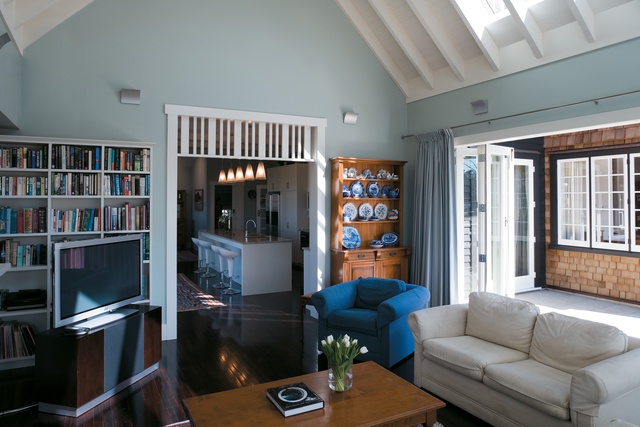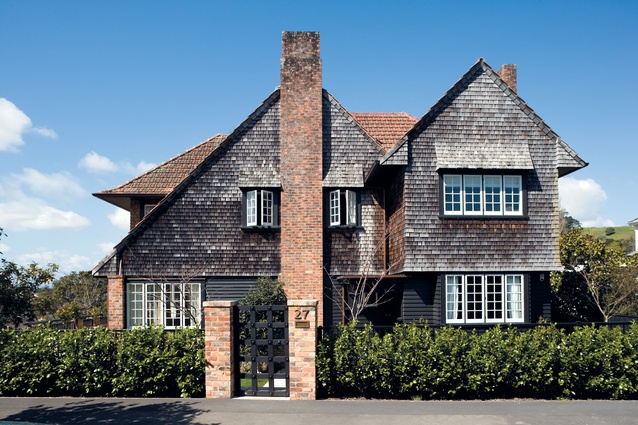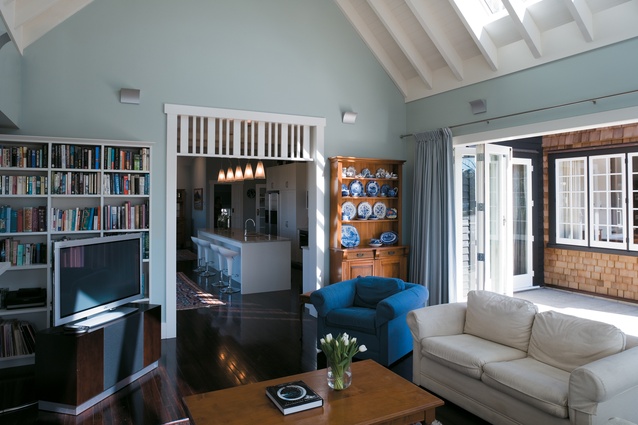Houses Revisited: Orthopaedic surgery
From the archives: On a fine old Auckland street, Robin O’Donnell has extended the life of a time-worn Arts and Crafts house with ‘good bones’.
Give us space, give us light, and stay true to the original design: that was Robin O’Donnell’s brief from the owners of a rundown Arts and Crafts house in Remuera. Located in a grand street on the suburb’s northern slopes – for a century, the epicentre of Auckland’s haute bourgeosie – the protected landmark residence was designed and built for himself in 1923 by Ralph Palliser Worley, the founder of Worley Engineering. Worley died in 1965, but two unmarried daughters stayed on until 1999. The Auckland couple who then bought the property commissioned rebuilding plans but sold up after three years, too busy to deal with such a demanding project.
Enter the new owners, moving into the city after many years out in Karaka, in Auckland’s rural hinterland, where they had restored a substantial homestead. They thought the Remuera house architecturally appealing and believed it would provide the ideal setting for their collection of early New Zealand furniture. Additionally, the house was “in a superb position in terms of both convenience and potential for capital growth”.
O’Donnell, too, was inspired by the beauty of the old shingle-clad house. He has long been interested in the Arts and Crafts movement, and in particular the work of the renowned English architect Sir Edwin Lutyens (1869-1944), whose own career progressed from Arts and Crafts to Classicism. O’Donnell, who honed his knowledge of Arts and Crafts design at an architecture summer school in Oxford, says he was able to draw on Lutyens’ work when he developed a design for his Remuera clients.
The owners and their four children lived in the old house while O’Donnell sought resource and building consents for a 270m2 extension. The Historic Places Trust also had to approve the drawings. In the event, no compromises were needed. According to O’Donnell, “[The Trust] knew that we were dealing with the house sympathetically and we had discussed the plans early on. They were comfortable with that.”

So what needed to be done? “The original house had good bones but there was an emphasis on very formal spaces rather than family life,” O’Donnell says. “It was also very dark. Our brief was to provide new informal living and sleeping spaces, and to open it up so the sun would stream in all day.” Generous internal garaging was also required.
There was little room for debate about where the extension could go. Typically for the 1920s, the house was built close to the street and across the width of the sloping site. A garden at the back led down to a disused tennis court, already registered by the Worley sisters as a separate title. The addition would have to be built over part of the garden, but a huge English oak tree presented another obstacle: it, too, was protected and any extension would have to be built outside the drip-line of the tree.
To add to the complications, the street in which the house is sited is one of Auckland’s most restricted residential zones; much of it has a limit of 25 per cent building coverage. The only way to get the space needed for the extension was to gain some land from the tennis court and from the house next door. Fortunately, the owners had also bought that property as part of their purchase package. They decided to pull down the old villa and, after shaving off the land they needed, replace it with a modern O’Donnell design (construction has just started).
At the Worley house, building work could only begin after the structure had been propped up. According to one of the owners, “The old girl was on a tilt. She was about ready to slide down the hill.” New foundations were laid, using suspended slabs to provide space for the roots of the oak tree, and all the interior walls were rebuilt. The choice of materials for the exterior was, by virtue of the house’s protected status, dictated by the original building; weatherboard and shingle cladding had to be used, along with tile roofing. The tiles were recycled from an old state house being demolished elsewhere in Remuera.
Much of the original house was re-shingled and all but two of the old windows were replaced. New windows were added on the western side to let in day-long sunshine. Existing window proportions and details were followed in the extension, and recycling was again a feature. Floorboards were milled from old weatherboards stripped off the back of the house and then stained. Discarded doors were used to make new cupboards. As the work progressed, it attracted much local interest. “People seemed pleased that a house they knew was being restored and improved, rather than bastardised,” the owner says.

O’Donnell’s design for the extension included a “waterfall roof, to ground the building better in the site and to echo the strong roof forms evident on the street front”. As a result, the exterior of the existing house blends seamlessly with the new wing. Visitors enter through the original hall, an imposing wood-panelled space complete with kauri-beamed ceiling, a large fireplace and a grand piano. An opening to the formal sitting room has been widened and awkward bi-fold doors removed. The sense of space provided by the 3.3m stud has been enhanced by opening up two small rooms on the far side, originally an open verandah. From the sitting room, often used for large-scale entertaining, guests can now wander through onto a new terrace, paved with Hinuera limestone.
The main extension runs right across the back of the old house, 6.3m deep. A four-car garage is incorporated in the basement, along with a guest bedroom and bathroom. Upstairs, an extra bedroom and bathroom are tucked into the new attic space. But it’s the new living areas downstairs that give the owners the greatest pleasure. A big, workable kitchen is flanked by a family room and an informal dining area; skylights and double-height ceilings have been used to capture the sun. A slender balcony with bi-fold doors runs across the back of the kitchen, overlooking the garden. O’Donnell says he didn’t really expect it to be used much, but the owners frequently open the doors right up, leaving the kitchen completely open down one side.
Tricia Dunlop from design firm Spatial Integrity helped to choose paint colours, cupboards and handles in keeping with the architectural heritage of the house, but there are contemporary touches, too. A row of modern lamps hangs above the central kitchen island, for example, and that new domestic staple, a flat screen television, is set high on the back wall.
The Arts and Crafts movement might have declined by the late 1920s, but in this Remuera house, which received a 2006 NZIA Auckland Local Architecture Award, Robin O’Donnell has gracefully ushered the style into the twenty-first century.
Click here to see more Houses Revisited. And sign up to our email newsletters to receive Houses Revisited straight to your inbox.
Note: These are stories from our archives and, since the time of writing, some details may have changed including names, personnel of specific firms, registration status, etc.













